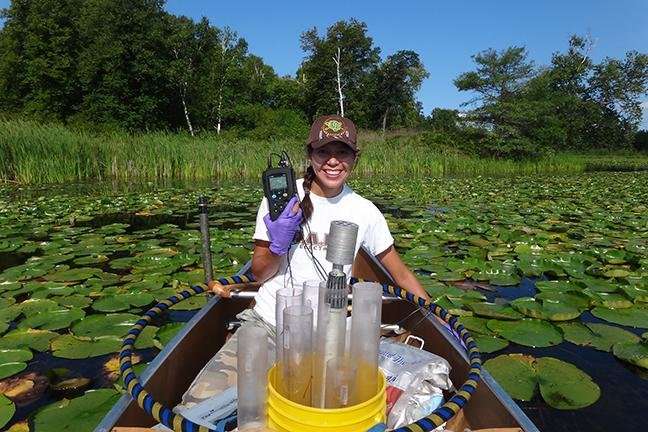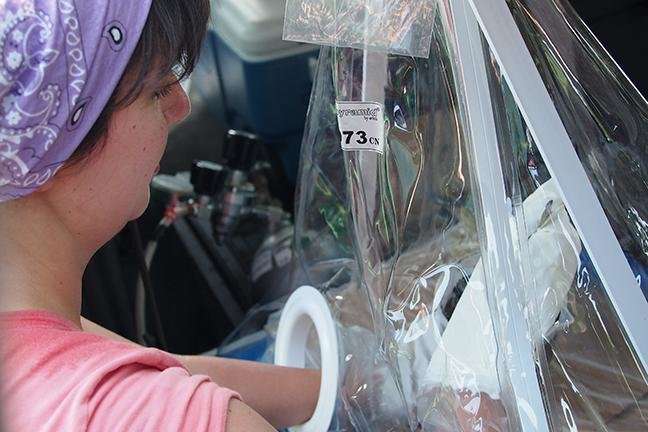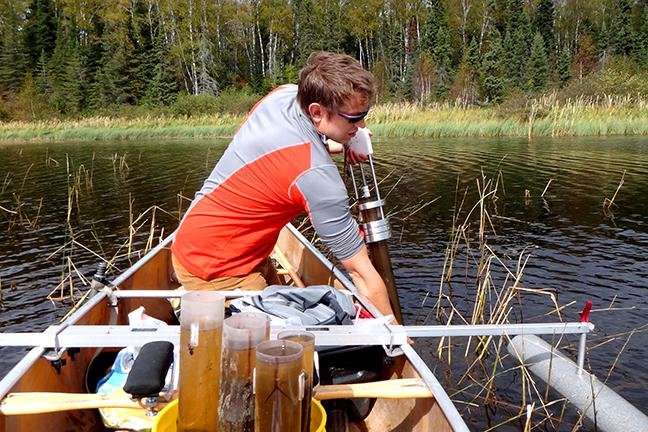Researchers use wild rice to predict health of Minnesota lakes and streams

By studying wild rice in lakes and streams, a team of researchers led by the University of Minnesota has discovered that sulfate in waterways is converted into toxic levels of sulfide and increases other harmful elements. This includes methylmercury, the only form of mercury that contaminates fish.
Sulfate is a compound that is released into fresh water from mining, sewage, fertilizers, fossil fuel combustion, and other human activity, as well as from natural geological sources in some parts of the state. The researchers recently published three related studies on the topic of sulfate in water in the Journal of Geophysical Research: Biogeosciences, published by the American Geophysical Union.
"Wild rice serves as a flagship species or the equivalent of our 'canary in a coal mine,' giving us a warning on how human activity affects our water quality in Minnesota," said Amy Myrbo, a research associate in the University of Minnesota's LacCore/CDSCO facility in the Department of Earth Sciences and lead author of two of the three studies. "The results of our studies are important because they show that increases in sulfate in our lakes and streams can have multiple negative consequences for ecosystems, even though sulfate itself is relatively benign."
Wild rice is culturally important to multiple groups in Minnesota, especially Native Americans. Wild rice also provides habitat and food for waterfowl and other wildlife. Research in the 1940s and 1950s found that wild rice grew best in low-sulfate Minnesota lakes, but no one knew why. The correlation was a puzzle, since sulfate isn't very toxic to plants or animals.

This new research finds that the problem is sulfide, not sulfate. Sulfate can be converted into toxic levels of sulfide in the soil of wetlands, like those in which wild rice germinates and roots. Wild rice is an annual plant that must sprout each spring from seeds that were dropped the previous fall into the wet soil. Anaerobic microbes in the soil make sulfide from sulfate in the overlying water. Lakes, streams, and wetlands that have high concentrations of dissolved sulfide in the sediment therefore have a low probability of hosting wild rice.
In addition to the release of sulfide, the researchers found that accelerated decomposition of plants in waterways caused by the sulfates releases phosphorus and nitrogen, which fertilizes the waterbody and can change the plant community within the ecosystem – including increasing algae blooms. The microbes that convert sulfate to sulfide also produce methylmercury, the only form of mercury that contaminates fish.
"Minnesota is unique among U.S. states and Canadian provinces in that it has a water quality standard that regulates sulfate," Myrbo said. "This isn't just about wild rice. We've now found that putting sulfate into our water has consequences down the line, including more mercury in fish, changes in habitat for ducks, and changes in the food chain."

Over three summers in 2011, 2012, and 2013, researchers studied water samples and sediment from more than 100 lakes and streams in Minnesota where wild rice grows or where they determined wild rice should be growing. Many of these waterways were in northeastern Minnesota where sulfate does not naturally occur. The researchers did more than 100 measurements at every site studying sediment cores, water in the sediment, surface water, and various plants. They analyzed things like the water's chemistry, depth and transparency.
In almost all cases, the water with the highest levels of sulfate had no wild rice, even though other conditions seemed ideal for the growth of the aquatic plant. The team's field research that showed the effects of sulfate on water quality mirrored studies by other researchers in tanks.
"Our research is based on hard science and showed the same results as other studies in artificial environments," Myrbo said. "We know that issues regarding our waterways can be very complex, but we hope our work can be used to make good public policy that balances the economic needs of our state with food sovereignty and protecting the environment."
More information: A. Myrbo et al. Increase in Nutrients, Mercury, and Methylmercury as a Consequence of Elevated Sulfate Reduction to Sulfide in Experimental Wetland Mesocosms, Journal of Geophysical Research: Biogeosciences (2017). DOI: 10.1002/2017JG003788
A. Myrbo et al. Sulfide Generated by Sulfate Reduction is a Primary Controller of the Occurrence of Wild Rice (Zizania palustris ) in Shallow Aquatic Ecosystems, Journal of Geophysical Research: Biogeosciences (2017). DOI: 10.1002/2017JG003787
C. D. Pollman et al. The Evolution of Sulfide in Shallow Aquatic Ecosystem Sediments: An Analysis of the Roles of Sulfate, Organic Carbon, and Iron and Feedback Constraints Using Structural Equation Modeling, Journal of Geophysical Research: Biogeosciences (2017). DOI: 10.1002/2017JG003785
Provided by University of Minnesota


















